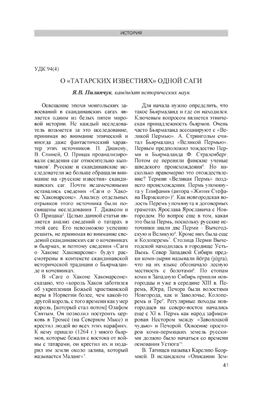Пилипчук Я.В. "О "татарских известиях" одной саги" // Научный
Татарстан. - №
3. - Казань, 2012. - С.41-61.
This article focuses on the analysis of information about Bjarmians and Tatars in Saga about the Hakone Hakonarson. The data in this saga about the flight of Bjarmians from the Tatars do not correspond to historical reality, and are a reflection of view of Scandinavians on the Mongols and their role in the history of Eurasia. Any event that could lead to the displacement of people in the middle of the XIII century was associated with Ulus Jochi. Jochids in the 60’s of the XIII century were busy on other fronts. Bjarmians is not Finnish-Permian nation, but Finno-Ugrian peoples that lived in Karelia and Dvina region. Two Bjarmalands of Scandinavian sources are Koloperem and Zavolochye of Russian sources. Most likely, Bjarmians voluntarily moved to Halogaland, and the author of the saga knew from the Slavic informants about events in the steppes of and just added this information, considering the cause of migration some dramatic events in the east. Information from Scandinavian sagas and geographical sources about the nomadic people are very vague. Blavkumannaland (Blokumannaland) is identified either with Danube Bulgaria, or with Dasht-i-Qipchaq. The same can be applied for information on the Tartar and Tattariki which reflected the events and the era of the Mongol conquests and the times of the Avar Khaganate.
3. - Казань, 2012. - С.41-61.
This article focuses on the analysis of information about Bjarmians and Tatars in Saga about the Hakone Hakonarson. The data in this saga about the flight of Bjarmians from the Tatars do not correspond to historical reality, and are a reflection of view of Scandinavians on the Mongols and their role in the history of Eurasia. Any event that could lead to the displacement of people in the middle of the XIII century was associated with Ulus Jochi. Jochids in the 60’s of the XIII century were busy on other fronts. Bjarmians is not Finnish-Permian nation, but Finno-Ugrian peoples that lived in Karelia and Dvina region. Two Bjarmalands of Scandinavian sources are Koloperem and Zavolochye of Russian sources. Most likely, Bjarmians voluntarily moved to Halogaland, and the author of the saga knew from the Slavic informants about events in the steppes of and just added this information, considering the cause of migration some dramatic events in the east. Information from Scandinavian sagas and geographical sources about the nomadic people are very vague. Blavkumannaland (Blokumannaland) is identified either with Danube Bulgaria, or with Dasht-i-Qipchaq. The same can be applied for information on the Tartar and Tattariki which reflected the events and the era of the Mongol conquests and the times of the Avar Khaganate.

